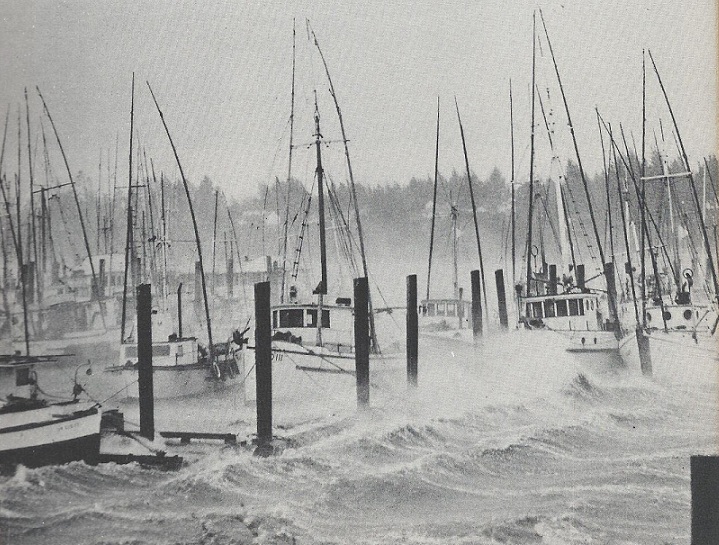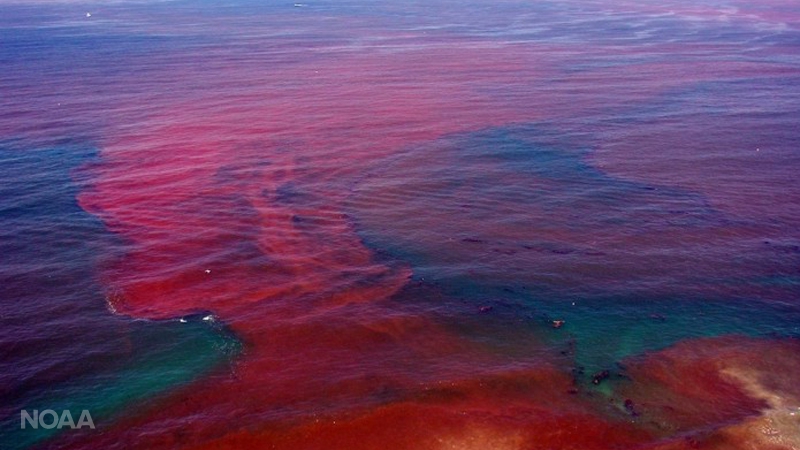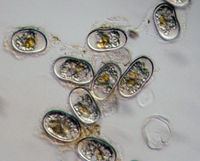
Meanwhile down at the docks.
Holiday Schedule. No Deliveries Thursday or Friday (Nor on Weekend).
OUT OF AREA SHIPMENTS- Monday shipping Only for urchin/crab. Fresh/Frozen Fish & shellfish shipping Mon-Wed.
SEATTLE DELIVERIES- Monday, Tuesday and Wednesday. Closed Th & F.
SAN JUAN ISLAND DELIVERIES- Tuesday ONLY.
SKAGIT DELIVERIES- Monday Only.
BELLINGHAM DELIVERIES- Wednesday Only.
It's going to be a good winter.....
Fall is now officially the mode of the day on the water and at Jones Ranch. Coho is definitively done--the last few we have seen have been nasty and snaky--bruise-colored flesh and thin belly walls. Best to let them spawn at this point. Halibut has been relegated to memory and frozen product. From here on 'till mid March West Coast Fish availability will be subject to weather, limited as far as species availability and generally squirrely. Fortunately, JFF has been diving and digging deep and far afield to keep you covered. Urchin fisheries continue strong and the urchins themselves are beyond lovely. Remember--every blow this time of year works to stretch out the urchin quota. Spot Prawns are suddenly, unaccountably, exploding out of the woodwork. Eastern fisheries are robust and varied, with good abundance of John Dory, Monk and various exotic offerings. Best of all, we are now on the one-week countdown to renewed Pink Scallop harvest and sales!!
Back on Point
Green is the New Uni!!!
We have not sold green urchins the last few years due to concerns about quality and consistency. The reds seem to be going from strength to strength, year by year, quality-wise, while the greens have lagged behind. Based on a batch we sampled last week, we are delighted to report that the greenies are back on. Green Urchin uni is sweeter, smoother and milder than red. We consider it a "gateway" Uni--perfect for gentler palates and new Uni-eaters. So from here on out, Green, as well as Red, means Uni.
Travis and friend.
Crab Pricing Falls to 2017 Low!!!!
California Coastal crab opened Weds and we expect volume to be excellent. Crab pricing has fallen to the lowest levels in 2017. Washington and Oregon Coasts are held up due to low meat yields in test catches, but overall abundance looks excellent and when those fisheries open, prepare for a crustacean deluge. Here in Puget Sound our tribal fleets are banging away with the best catches being in the San Juan Islands. State crabbers will likely go back on the water around the holidays. What this means is a unique combination of abundant supply and moderate pricing. Now is the season to run a crab program. As ever, unlike the broadliner competition, we specialize in Puget Sound Crab, the Acme of Dungeness Crab.
Spot Prawn Bonanza!
Prawn-O-Rama!
After years of poor and fitful spot prawn availability and extremely high pricing, we now have an abundance of high-quality frozen prawn tail options. We have size-graded 2016 product for excellent prices, O/R 2017 production at reasonable prices and size-graded 2017 tails for acceptable prices. Your choice!. Some of our fussiest customers have been delighted with the 2016 and are buying large volumes to secure availability. The frozen-in-brine prodcut pictured is the finest retail pack we have ever seen. Check the pricelist--Don't let the best prawns in the world slip by!
The Scallop Fishery is almost in Hand
Pink Scallops are Almost Back!!
It's almost time to welcome back the elusive princess of your seafood menu, the legendary Pink or Singing Scallop. The extreme seasonality of the scallop only makes them more precious in our minds, but there again is a story to be told. After a barn-burning spring of scallop harvest and sales, things came to a screeching halt in mid-June as PSP, or red tide levels hit dangerous levels. Since then the Scallops in our storage system have stubbornly held onto PSP levels oscillating just around the danger zone. It has been deeply frustrating. This week we finally realized a safe test result on both our storage-held scallops and product fresh from the harvest grounds. Assuming we get clean results come Monday, we are back in the scallop business. Given the holiday, figure first deliveries the week of the 27th. Long-time Fish-O-Gram readers understand the epic struggle that bringing the scallop fishery back on line has been. Every scallop harvested and sold is a victory and a triumph--a triumph for culinary endeavor and the human spirit over the nightmare molasses of fish bureaucracies. But the creature that has bedeviled us these past months is not on the government payroll.

I don't work for the City, I don't work for the State
.
Science Corner, HAB Edition.
We here at Jones Ranch have become fascinated by Biotoxin-producing algae. After all, we have a positive relationship with phytoplankton in general. We grow it at the shellfish hatchery for our baby oysters, wild algae is the fodder that grows our oysters and feeds the salmon we treasure. The magically-named Noctiluca scintillans (translation: twinking night light) creates the phosphorescence, or fire in the water that is the joy of night-time seagoers world wide. Algae is the building block of life in the watery reaches of the world and it supplies 80% of the oxygen we consume and is by far the largest driver in global carbon cycles--this is fascinating topic, by the by. Our third child grows algae in jars on the kitchen table.
We love Algae
When Algae Goes Bad....
F.O.G. would go so far as to claim an affinity with and affection for phytoplankton that most people have with puppies or sloths. How then to consider algae turned bad? Harmful Algal Blooms, or HABs as they are known in the business, cause massive harm--from the potentially fatal Paralytic Shellfish Poisoning to the hazards of Domoic Acid, caused by blooms of Pseudo-nitzschia phytoplankton, to the newly emerged threat of DSP, or Diaretic Shellfish Poisoning, which is at is sounds. HABs cause huge disruptions in seafood supply--though generally blooms are not generally harmful to lower-order marine organisms. Plankton-eating shellfish and some species of fish and crab concentrate the compounds. When these creatures are in turn eaten by animals with central nervous systems, like otters, whales and humans, trouble arises. Otters in particular seem to be subject to heavy mortality from eating tainted clams.
F.O.G. would go so far as to claim an affinity with and affection for phytoplankton that most people have with puppies or sloths. How then to consider algae turned bad? Harmful Algal Blooms, or HABs as they are known in the business, cause massive harm--from the potentially fatal Paralytic Shellfish Poisoning to the hazards of Domoic Acid, caused by blooms of Pseudo-nitzschia phytoplankton, to the newly emerged threat of DSP, or Diaretic Shellfish Poisoning, which is at is sounds. HABs cause huge disruptions in seafood supply--though generally blooms are not generally harmful to lower-order marine organisms. Plankton-eating shellfish and some species of fish and crab concentrate the compounds. When these creatures are in turn eaten by animals with central nervous systems, like otters, whales and humans, trouble arises. Otters in particular seem to be subject to heavy mortality from eating tainted clams.
Beware the Birds.
Some impacts from HABs are downright whimsical, Nitzschia navis-varingica can cause temporary amnesia in humans and animals, or Amnesic Shellfish poisoning. Alfred Hitchcock drew from a real-life invasion of confused, belligerent seabirds in Capitola California in 1961, presumably caused by a Nitzschia navis-varingicabloom in nearby waters, to flesh out the horror film, "The Birds" More recently, a deranged Pelican flew through the windshield of a motorist on the Pacific Coast Highway in 2006. Accident investigators fingered AmnesicShellfish poisoning as the aggravating factor. Washington State Department of Health has monitored for HABs since the early 1940s and the program has developed into the best and strongest in the nation. Yet for all the resources dedicated to identifying HABs and mitigating their impacts on humans and seafood supply, remarkably little is known about the whys and wherefores--there seems to be no good reason for plankton to create toxins--it is costly to the organism and does not seem to benefit the algae, and yet a wide range of them do. Some toxic algae, like Pseudo-nitzschia, turn their toxin-producing capabilities on and off based on unknown environmental or biological cues. At times plankton monitoring will identify huge abundance of Pseudo-nitzschia with little or no toxin being produced. Others species, like Alexandrium catenella, the PSP, or saxitoxin producing algae, are always on--when present, they are producing PSP toxin. Because producing toxin is so costly to the algae, species producing toxins are generally very narrowly adapted. This is good in one sense, as they are not fit to compete with the general run of phytoplankton, and so blooms are rare. But when conditions line up, the harmful species have the capacity to explode in abundance and dominate the ecosystem for a period of time. The best operating theory is that these particular species of algae were, sometime in the dim genetic past, colonized and co-opted by toxin-producing viruses.
Different species of shellfish concentrate, clear and hold the toxin at vastly different rates. Mussels are typically the fastest to accumulate toxin and the quickest to release it. Because of this sensitivity, mussels are typically used as the sample species to monitor PSP. Butter clams and geoducks are the slowest both to take up toxin and then to release it--a geoduck farmer friend some years back faced a full year of harvest closure. His ducks went hot in mid-spring one year, stayed mildly hot through the summer months, then went into dormancy without clearing the toxin. Jerry Borchert, PSP guru for the DOH, speculates that different species have various degrees of "stickiness" for saxitoxin in gut lining and soft tissue. And our geoduck friend? After a year with no revenue his business more or less collapsed. Taylor Shellfish took over his leases and last we heard he was renovating and flipping houses in Tucson Arizona.

The long-term impacts of PSP
Biotoxins are always with us.
Harmful algaes are nothing new. Coastal dwellers have known of toxic algae, and known that it concentrates in filter feeders, as long as people have lived on the coast. Local natives would feed suspect shellfish to dogs before consuming it themselves. San Juan County herbalist and folklorist Ryan Drum tells a story of a feast sometime in the early dawn of European contact wherein Vancouver Island natives deliberately fed toxic mussels to Spanish fur traders, with predictable results. Biotoxins are not all bad, the Japanese have used Pseudo-nitzschia derived compounds as wormers for millennia. Modern medicine is finding all kinds of uses for these compounds, including as highly effective treatment for anal fissures. Both the range and frequency of toxic algal blooms seems to be increasing. This may be a result of warming seas, nutrient loading, better tracking and detection, some form of cyclical variation, or all of the above. Some years in Puget Sound are bad biotoxin years, some are not. The last few years have been quite benign, though we did have an unexpected spike in this last October.
Same as it ever was
Scallops and PSP.
The primary tool WA DOH uses to monitor PSP outbreaks is a robust predictive model based on 70 years of testing and tracking PSP outbreaks. If X area turns up hot, more than likely area Y will follow. Areas typically prone to PSP are monitored regularly during weather conditions generally associated with Alexandrium blooms. What this means in practical terms is that if Chuckanut and Mackaye Harbor turn up hot, Jerry Borchert will begin rounding up samples from the next tier of sites, say Eastound, Olga and Shoal Bay. This system works very well. Washington State commercial shellfish has been remarkably safe for many decades, in spite of increasing seasonal and geographical occurrence of HABs. The particular glory of Alexandrium is an uncommonly strong swimming ability--therefore they flourish in times of striated water conditions, with limited mixing between water layers. When upper layers of water become depleted of nutrients other, less mobile plankton fade out. Alexandrium are able to swim down to deeper water, tank up on nutrients, then hoist themselves back up to bask in the sunlight. They typically thrive in areas of clean, clear water with high salinity--this is why the Straits frontage of the Olympic Peninsula is so prone to shellfish closures. Contrary to popular belief, Alexandrium are not more common in heavily polluted areas—the areas in our state most prone to outbreaks actually have the cleanest water. When conditions turn less favorable for the Alexandrium, large numbers of the algae will cocoon themselves and form dormant cysts that can live on the seabed for years or decades. Ultimately, when conditions warrant, the algae react to some unknown cue, break out of their cyst, swim to the surface and begin merrily photosynthesising, dividing and creating toxin as if they'd never quit. Many algae species have a cystic cycle-this is what the vast biomass of deep-water filter feeders subsist on, and there is no way to predict when and how deep-water feeders will come upon a batch of cystic Alexandrium. DOH's predictive models are of little use in tracking PSP levels in deep-water species like scallops. Further, DOH had very little data on how and with what speed scallops uptake the toxin and how and with what speed they release it.

It's the quiet ones you need to watch out for.
JFF, Expanding the Boundaries of Human Knowledge.
The old-time scallop fishery foundered on this problem--every harvest batch needs to be tested. A scallop with an effective shelf life of three or four days cannot be harvested, held out of the water for the duration of a test and then delivered to market with any degree of success. Our process is that harvested scallops are transferred to our holding system and held in water while the test is going through. Being held in our growing area means no surprises--This allows us to ship guaranteed fresh and guaranteed clean scallops. Our thinking going into this exercise was that hot scallops transferred into the tanks, as happened last June, would rapidly purge themselves of saxitoxin, given the high metabolism of a swimming scallop. Unfortunately, this proved not to be the case. Scallops have proven to take up the toxin faster than mussels and release it more slowly than almost any other creature. Certain weeks side-by-side testing showed no detectable toxin in mussels while at the same time PSP levels in the scallops were spiking. This is wonderfully interesting from a research perspective, but frustrating from a commercial point of view. Moving forward we are going to begin using a pregnancy-checker-esque PSP test as a pre-screen for scallops to help us target harvest and reduce the strain on the DOH lab, not to mention the lab mouse population. This too will be deeply interesting.
The old-time scallop fishery foundered on this problem--every harvest batch needs to be tested. A scallop with an effective shelf life of three or four days cannot be harvested, held out of the water for the duration of a test and then delivered to market with any degree of success. Our process is that harvested scallops are transferred to our holding system and held in water while the test is going through. Being held in our growing area means no surprises--This allows us to ship guaranteed fresh and guaranteed clean scallops. Our thinking going into this exercise was that hot scallops transferred into the tanks, as happened last June, would rapidly purge themselves of saxitoxin, given the high metabolism of a swimming scallop. Unfortunately, this proved not to be the case. Scallops have proven to take up the toxin faster than mussels and release it more slowly than almost any other creature. Certain weeks side-by-side testing showed no detectable toxin in mussels while at the same time PSP levels in the scallops were spiking. This is wonderfully interesting from a research perspective, but frustrating from a commercial point of view. Moving forward we are going to begin using a pregnancy-checker-esque PSP test as a pre-screen for scallops to help us target harvest and reduce the strain on the DOH lab, not to mention the lab mouse population. This too will be deeply interesting.
Scallops to the Rescue!!!
Scallops to the Rescue!!!
So bust out your pink party hats, whip up some mignonette and pour another glass of sancerre. The scallops, safe, certified and island-fresh are headed to your menus. Just in time for the holidays and just in time to relieve the seasonal-seafood doldrums. It's going to be a good winter. New customers; please take a moment to check out our archive of Scallop-themed information and the excellent roster of press about the return of the scallop fishery at our website, jffarms.com.
As for Jerry Borchert, Audrey Coyne, Clara Hard and the other good folk involved with the DOH biotoxin program, who have an unparalleled record for keeping diners safe while enabling the Washington State Shellfish industry to grow and thrive, JFF salutes you.

Be safe. Lay off the barnacles.
Please join us for an oyster and pink scallop tasting event at Franks Oyster House 5-8pm December 5!!!!
In our expanded capacity as Marinelli Shellfish Reps we will be holding as many of these vents as we can find venues to do so in coming months. Please reach out if you would like to host one.
The last event, at the White Swan Public House was a storming success, as was Elliot's Oyster New Year last weekend. We are delighted to report that the Hammersley, our November Oyster of the Month, swept the prize board at Oyster New Year. Congratulations Troy Morris and the entire Calm Cove crew!!!!!!
Until next time we are your Green Urchin-Cracking, Freezer-Diving, Scallop-Sciencing, Safely-Barnacle Harvesting, Award-Winning Oyster-Selling JFF Crew!
Call, Email or text.

